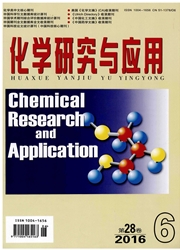

 中文摘要:
中文摘要:
利用聚甲基氢硅氧烷(PHMS)与4-(β-羟基-γ-烯丙氧)丙氧基-2-羟基二苯甲酮(MUV-O)、α-烯基聚醚(F6)的硅氢化加成反应,合成了一种新型聚醚-二苯甲酮衍生物侧基聚硅氧烷PE-PUVSi,用红外光谱(IR)、紫外光谱(UV)、核磁共振氢谱(^1H-NMR)以及原子力显微镜(AFM)等仪器对产物的结构和成膜形态进行了研究。结果表明,新合成的PE-PUVSi对波长为243.6、289.2、325.0nm的紫外光有强吸收作用。在纤维及单晶硅表面,PE-PUVSi均可成膜。但宏观上平滑的PE-PUVSi膜,微观上实则呈非均一、相分离结构,其中UV侧基以纤细尖峰分布在聚硅氧烷膜表面,而亲水性聚醚基团则卷曲堆积成峰包。
 英文摘要:
英文摘要:
A new water-soluble polysiloxane (PE-PUVSi) finishing agent bearing pendant benzophenone derivative and polyether side groups was synthesized by hydrosilylation of polyhydromethylsiloxane (PHMS) with 4-(β-allyloxy-γ-hydroxy) propyloxy-2- hydroxy benzopbenone (MUV-O) and ct-allyl derivative of polyetber(F6). Chemical structure of the synthesized polysiloxane was investigated and characterized by IR, ^1H-NMR and ultraviolet spectrum. And the film morphology of PE-PUVSi on cotton fiber and silicon wafer substrate surfaces were observed by scanning electronic telescope SEM and atomic force microscope (AFM). Experiment results indicated that PE-PUVSi had an intensive UV-absorbing capacity at wavelengths of 243.6nm,289.2nm and 325.0nm. In addition, PE-PUVSi could form a polysiloxane film both on fiber and silicon wafer surface. On silicon wafer surface, the macroscopic smooth PE-PUVSi film actually showed a microscopic un-homogeneous and phase-separated morphology in its AFM images. There were many slim pinnacles and mountains scattered on the PE-PUVSi film surface, and the slim pinnacles were estimated to result from the UV groups while the big mountains maybe arise from the curled gigantic polyether groups linked to the polysiloxane skeleton.
 同期刊论文项目
同期刊论文项目
 同项目期刊论文
同项目期刊论文
 期刊信息
期刊信息
